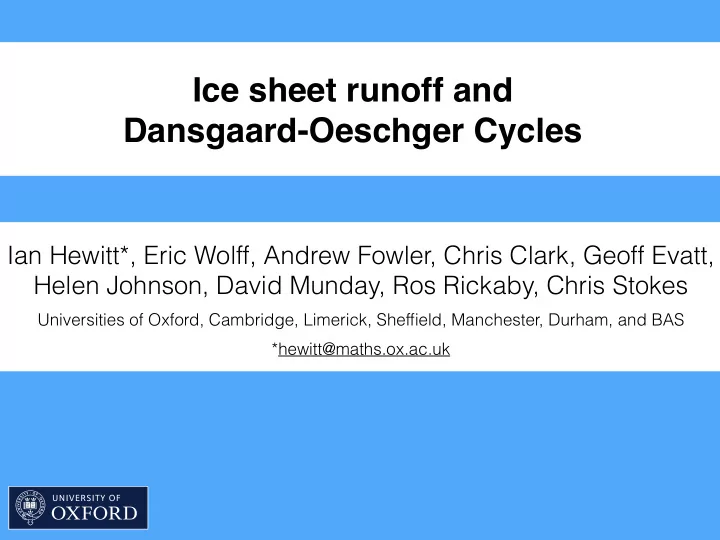

Ice sheet runoff and Dansgaard-Oeschger Cycles Ian Hewitt*, Eric Wolff, Andrew Fowler, Chris Clark, Geoff Evatt, Helen Johnson, David Munday, Ros Rickaby, Chris Stokes Universities of Oxford, Cambridge, Limerick, Sheffield, Manchester, Durham, and BAS *hewitt@maths.ox.ac.uk
Can feedbacks associated with meltwater runoff from ice sheets help explain D-O cycles? by appealing to available evidence and simple models
Dansgaard-Oeschger cycles -38 5 6 7 8 δ 18 O [ppt] -40 ~10 C -42 -44 -46 30 32 34 36 38 40 Age [ka b2k] -34 MIS 2 MIS 3 MIS 4 MIS 5 -36 -38 δ 18 O [ppt] -40 -42 -44 NGRIP MIS 1 -46 0 20 40 60 80 100 120 Age [ka b2k] (GICC05 extended) Time
Distinctive features Rapid warming at onset (‘D-O event’) non-linear feedbacks Global temperature change obeys bipolar see-saw AMOC important Quasi-periodic - cycles repeat without obvious trigger No D-O cycles during interglacials, nor during coldest glacial periods (LGM, MIS4) Heinrich events occur when climate already cold
Distinctive features Rapid warming at onset (‘D-O event’) non-linear feedbacks Global temperature change obeys bipolar see-saw AMOC important Quasi-periodic - cycles repeat without obvious trigger self-sustaining oscillations ? No D-O cycles during interglacials, nor during coldest glacial periods (LGM, MIS4) Heinrich events occur when climate already cold
Distinctive features Rapid warming at onset (‘D-O event’) non-linear feedbacks Global temperature change obeys bipolar see-saw AMOC important Quasi-periodic - cycles repeat without obvious trigger self-sustaining oscillations ? No D-O cycles during interglacials, nor during coldest glacial periods (LGM, MIS4) ice sheets important ? Heinrich events occur when climate already cold
Distinctive features Rapid warming at onset (‘D-O event’) non-linear feedbacks Global temperature change obeys bipolar see-saw AMOC important Quasi-periodic - cycles repeat without obvious trigger self-sustaining oscillations ? No D-O cycles during interglacials, nor during coldest glacial periods (LGM, MIS4) ice sheets important ? Heinrich events occur when climate already cold Heinrich events not important ?
Background Many models exist - most invoke changes in ocean circulation to help explain global pattern Sudden freshwater sources to North Atlantic - e.g. Clark et al 2001, Ganapolski & Rahmstorf 2001 Ice shelf growth and sea ice - Petersen et al 2013 Sea ice and North Atlantic stratification - Dokken et al 2013, Jensen et al 2016 Atmospheric-sea ice-ocean feedbacks caused by changing height of Northern hemisphere ice sheets - e.g. Zhang et al 2014 Salt oscillators - Broecker et al 1990, Birchfield & Broecker 1990, Peltier & Vettoretti 2014 Meltwater routing through the Arctic has most effect on AMOC Condron & Winsor 2012
Hysteresis in ocean circulation Warm AMOC strength Q Cool Freshwater forcing F Stommel 1961, Ganapolski & Rahmstorf 2001, Rahmstorf et al 2005
Oscillation mechanism Strong AMOC produces warmer Northern hemisphere warming accentuated by sea ice - albedo feedback Leads to more runoff from ice sheets This freshwater sends AMOC onto weaker branch Cooling reduces runoff and starves ocean of fresh water Sends AMOC back to strong branch Effect of runoff on ‘freshwater’ delivery is buffered by changes in Arctic Ocean salinity
Model schematic Ice E R N R A R A S F S N K X S D Arctic Q Atlantic
Arctic Ocean
− Model equations ∝ Q b τ dQ AMOC dt = f ( Q ) − F. phenomenological model of hysteresis in ocean models = F Runoff R A = R 0 + λ ( Q − Q 0 ) ; Ice E R N R A amplification by ocean and sea ice rolled into + λ R A S F S N ✓ ◆ 1 − S D K Freshwater X S D F ≈ F ∗ + ( X + R A ) S N Arctic Q effective freshwater flux through Fram Strait Atlantic dS D Salinity ≈ X ( S N − S D ) − R A S D V D dt salt balance for deep Arctic (fresher surface layer evolves more rapidly) Non-linear dynamical system - relaxation oscillation Parameters estimated using current day values
Oscillations Ocean equilibrium curve Decreasing salinity 26 24 22 Salinity equilibrium curve Q [ Sv ] 20 18 16 14 -0.02 0 0.02 F [ Sv ]
Oscillations Ocean equilibrium curve Decreasing salinity 26 24 22 Salinity equilibrium curve Q [ Sv ] 20 18 5 ∆ T [ K ] 0 16 -5 14 36 -0.02 0 0.02 F [ Sv ] 34 S [ ppt ] 32 30 28 26 0 1000 2000 3000 4000 Time [years] Time
Oscillations Ocean equilibrium curve Decreasing salinity 26 24 22 Salinity equilibrium curve Q [ Sv ] 20 18 5 ∆ T [ K ] 0 16 -5 14 36 -0.02 0 0.02 F [ Sv ] 34 S [ ppt ] 32 30 Time scale controlled by Fram Strait exchange 28 26 To get ~1000 years, exchange flow around 10 0 1000 2000 3000 4000 times smaller than present day Time [years] Time
Can we rationalise observed variability? A slow change of parameters can alter period of cycles, or produce steady (but ‘excitable’) states. Reduced sensitivity of Increased background runoff to AMOC runoff 26 26 24 24 22 22 Q [ Sv ] Q [ Sv ] 20 20 18 18 16 16 14 14 -0.02 0 0.02 -0.02 0 0.02 F [ Sv ] F [ Sv ] Interglacials (no ice) ? LGM (Arctic melt pathway blocked) Clark et al 2001
Summary Investigated a possible mechanism for D-O cycles, combining AMOC hysteresis and temperature-driven runoff Successes Self-sustaining oscillation - gives rise to regular ‘shape’ of D-O cycles Variable frequency, and lack of events during interglacials and during LGM, are naturally explained No sudden source of freshwater required (though could prolong cold stadials) Potential issues Relies on lengthy buffering effect of Arctic Ocean - lower exchange flux Any evidence for lower exchange flux, or lower salinities? Or other relevant data? Ideas (ice-sheet runoff & routing) need exploring in more comprehensive models to test whether this mechanism important
Recommend
More recommend